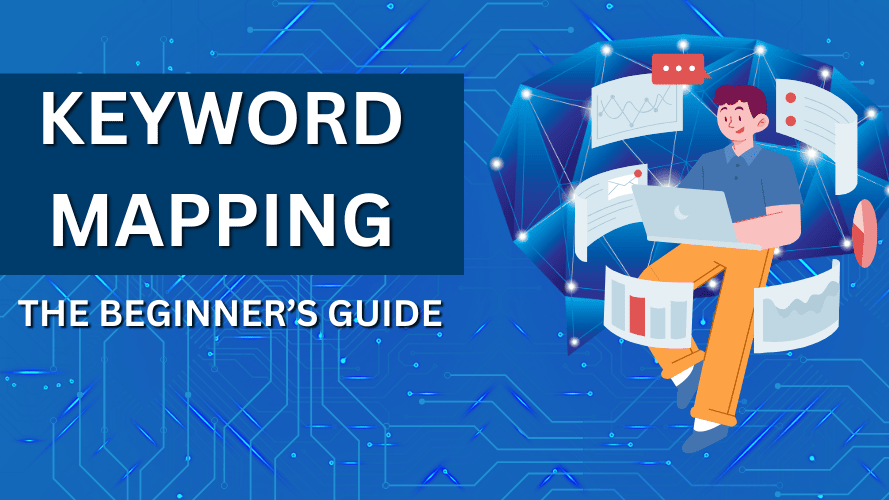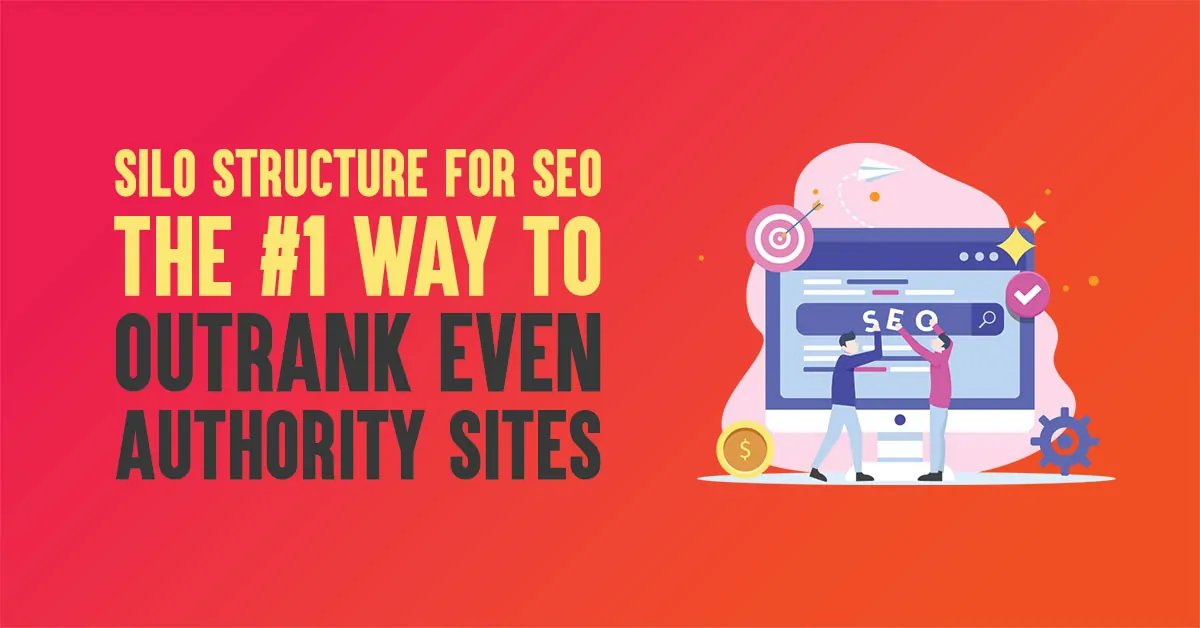Did you know that 75% of people never scroll past the first page of search engines like Google? (Source: HubSpot)
What does it mean? If your website is NOT ranking on the first page for desired keywords, you’re losing a lot of traffic and sales.
The loss of search traffic could be worth millions if you’re running a SaaS business.
That’s why you need Saas SEO. SaaS (Software as a Service) SEO is optimizing a SaaS company’s website to rank higher in search results for keywords relevant to their products or services.
The better your SaaS website is optimized for search engines, the more likely it will be found by people who are searching for information about your products.
In this guide, you’ll discover 5 of the best tips for SaaS startups. Let’s get started without much ado.
Table of Contents
SaaS SEO Strategy: 5 Best Practices to Rank Your SaaS Website on Google

1. Smart keyword research
Keyword research is the MOST important for SaaS businesses.
No matter what software you’re providing as a service, you need to find relevant keywords around your product.
For example, an SEO software company website like Semrush wants to rank for keywords like “link building tool,” “keyword tool,” “site audit tool,” etc.
All the above keywords are highly relevant to Semrush’s products and services, and they are also keywords that can lead to more TARGETED traffic and conversions.
Gone are the days when you can rank for most keywords with keyword stuffing.
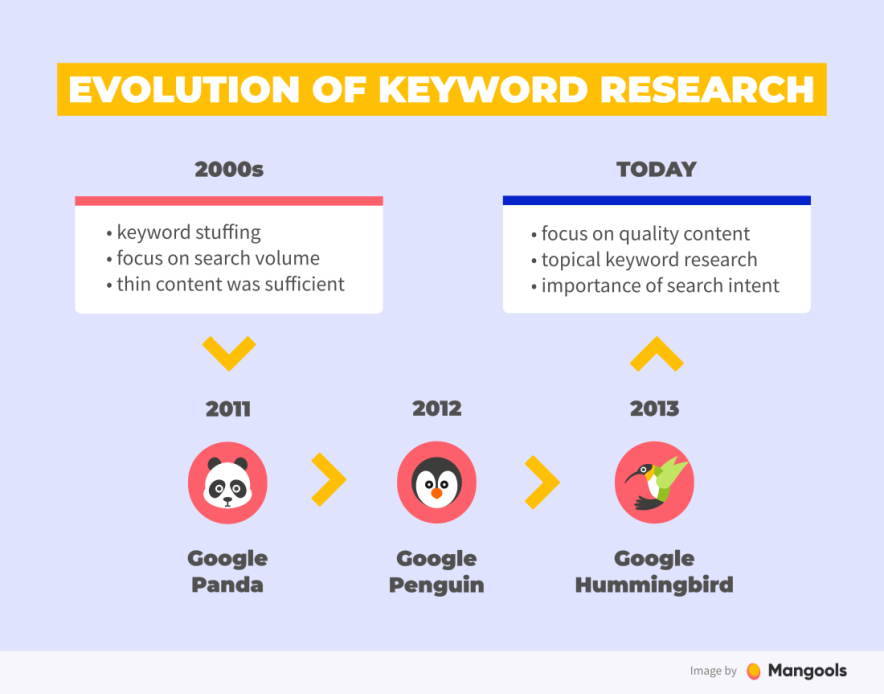
You need to find highly relevant keyword phrases for your SaaS website. Here are some PROVEN tips for finding relevant keywords for your SaaS website.
- Start by brainstorming a list of ALL The keywords related to your products or services you’re offering. You can consider all the problems your products solve, the features they offer, and the benefits they provide.
- Use keyword research tools to help you find more relevant keywords, such as Semrush, AnswerThePublic, KWFinder, etc. These tools can help you identify keywords with high search volume, low competition, and good commercial intent.
- Analyze your competitors’ websites to see what keywords they are targeting. You can’t skip this step, as you need to find out what keywords are MOST profitable in your industry.
- Try to find long-tail keywords. Long-tail keywords are more specific than short-tail ones and are often easier to rank for.
Here’s one more tip for SaaS websites: analyze Q&A platforms like Quora and niche forums to find hidden keywords you might’ve missed out on.
You can also use tools like AlsoAsked.com to find question-based keywords for your SaaS website.
If you’re curious, AlsoAsked.com is a freemium tool that collects and displays “People Also Ask” data that appear in Google search results for any topic you want to rank for.
Here’s an example for the topic “SEO tools”;
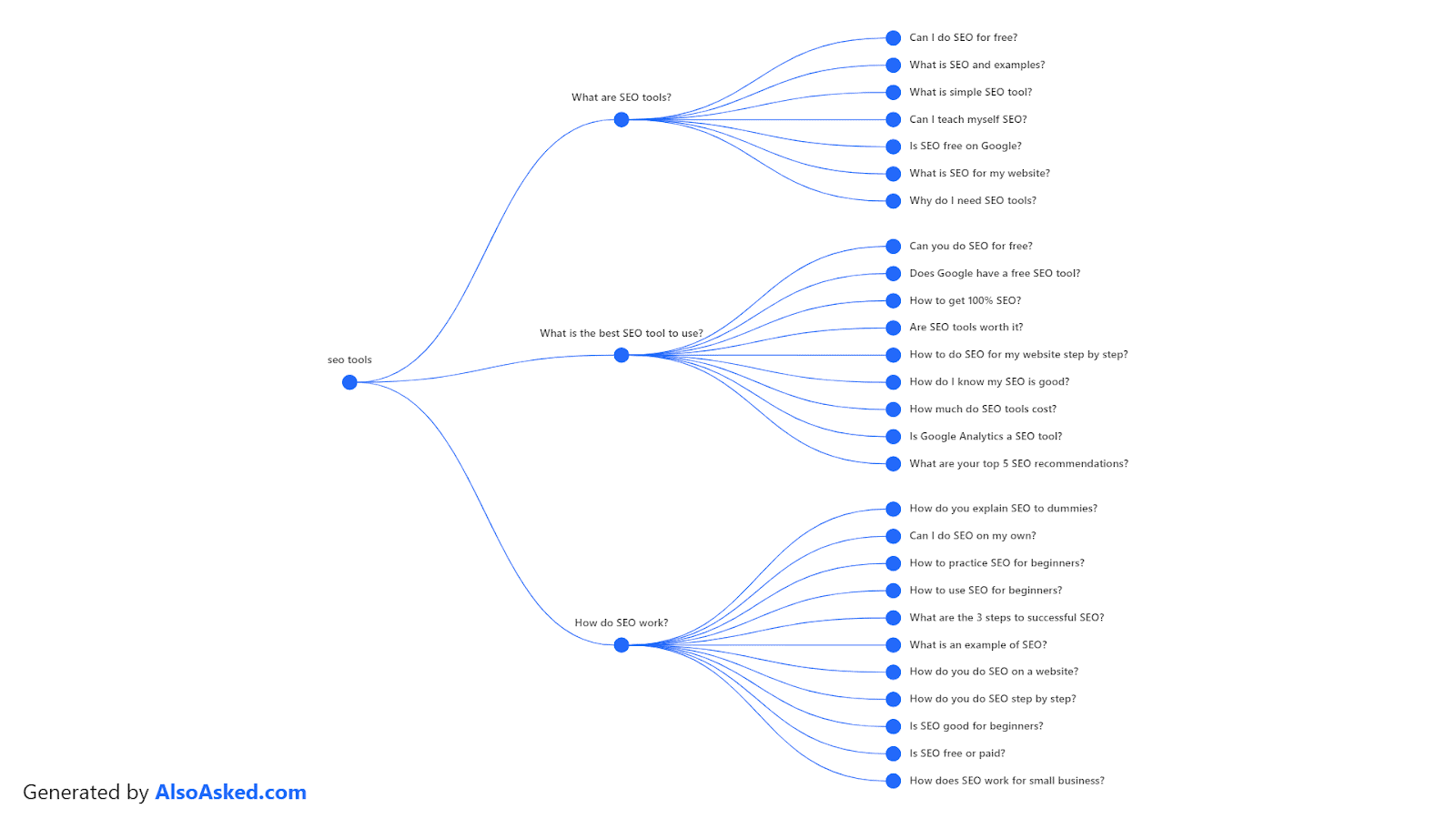
As you can see above, for the keyword “SEO tools,” AlsoAsked.com generated a ton of relevant question keywords.
Question keywords are excellent for many reasons, such as;
- They can help you rank for featured snippets
- They are easier to rank for (as they’re mostly long-tail keywords with less search volume)
- Better conversions
- More targeted traffic and so on
You can use an FAQ section in your blog posts, case studies, or product pages to target these question keywords.
2. Search intent is important
Finding relevant keywords is only the beginning.
You MUST create content according to the search intent to rank higher in search results.
There are FOUR types of keyword intent;
- Navigational intent (people want to find a specific page, e.g., “Twitter login”)
- Informational intent (people want to learn more about something, e.g., “what is Saas SEO”)
- Commercial intent (search users want to do research before making a purchase decision, e.g., “best AI tool”)
- Transactional intent (people want to complete a specific action, usually a purchase, e.g., “buy iPhone 15 pro”)
Make sure to categorize all your keywords in the above-mentioned four primary types of search intent.
For example, the keyword “how to check website traffic” has informational search intent, whereas “best website traffic checker tools” has commercial search intent.
If you want to find the intent of ANY keyword or topic, you can use a tool like Semrush keyword magic.
Here’s what the search intent on Semrush looks like;
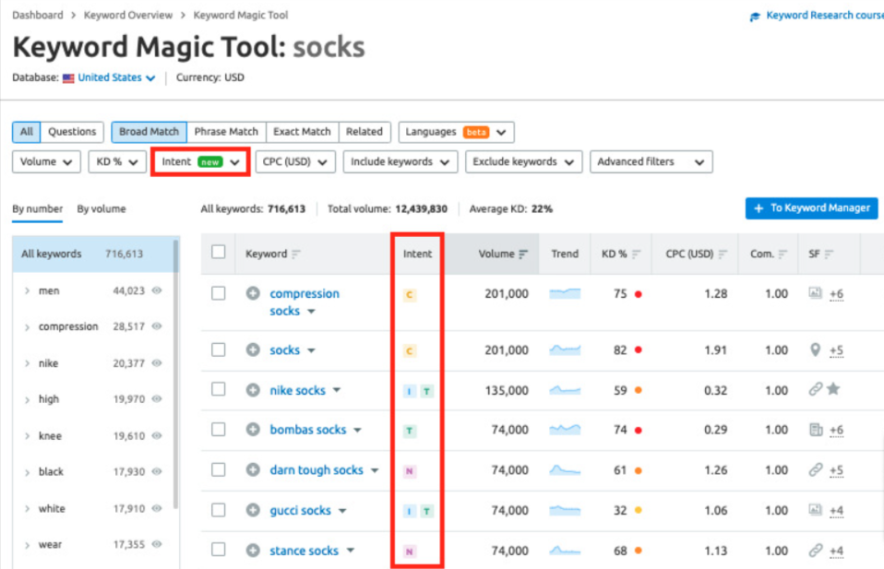
See that? Semrush keyword tool shows various types of intent for the keywords it generates, so you can easily find relevant keywords for your business.
3. Use Saas SEO tools
If you’re running a SaaS company, you need to invest in the RIGHT SEO tools.
Here are THREE powerful SaaS SEO tools most experts use in 2024.
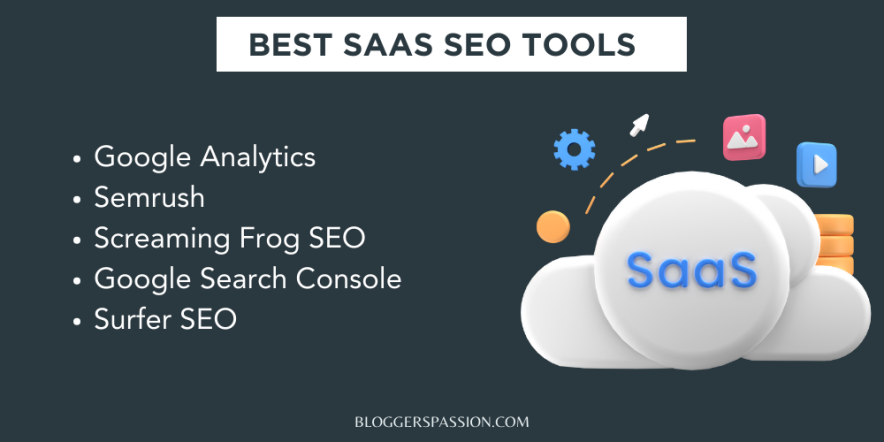
1. Semrush
Semrush is an essential SEO software for every SaaS business, offering over 55 tools under one platform. It’s also one of the popular SEO tools used by 10+ million users worldwide.
From keyword research to competitor analysis, website audits, PPC ads – you can do almost every SEO task using Semrush.
Benefits of Semrush for SaaS:
- It has a massive keyword database of over 25 billion keywords, so you can find hundreds of profitable keywords for your business.
- Offers amazing tools to analyze your competitors as you can estimate their traffic, top pages, links, identify content gaps, and more
- The ability to easily perform in-depth website audits to find and fix your technical issues
- Track your backlink profile and keyword rankings over time and see how they impact your search engine rankings.
- Above all, you can easily find out your competitors’ paid ad campaigns, so you can see what keywords they are targeting and how much they are spending
Pricing: Semrush comes in 3 pricing plans, which are listed below.
- Pro plan costs $119.95 per month, where you can add up to 5 projects, 500 keywords to track, and 10,000 results per report.
- Guru plan costs $229.95 per month, where you can add up to 15 projects, 1500 keywords to track, and 30,000 results per report.
- Business plan costs $449.95 per month, where you can add up to 40 projects, 5000 keywords to track, and 50,000 results per report.
Try 14 Days Free Trial of Semrush
2. Google Search Console (GSC)
GSC is an essential tool for all SaaS website owners which is a free SEO tool from Google. It helps you check your website’s indexing status, search queries, crawling errors, and more.
If you want to monitor Google Search results of the SaaS website, you need to access GSC.
Benefits of GSC for SaaS:
- Google Search Console is a free tool that is accessible to website owners of all sizes and budgets.
- Identify your site’s indexing issues (both on desktop and mobile)
- Find out what search queries are bringing you the most amount of clicks from Google
- Quickly monitor your website’s crawling issues
Pricing: It’s free.
3. Surfer SEO
If you want to improve your SaaS website’s search traffic, you must try Surfer SEO. it gives you all the tools you need to grow your website’s organic traffic, increase your visibility, and improve your keyword rankings.
Benefits of Surfer SEO for SaaS:
- It offers an AI writing tool that helps you with content research, content writing and optimization with a click.
- It can be effortlessly integrated with major platforms, including Google Docs, WordPress, Jasper AI, and more.
- Offers a keyword research tool that helps you discover a ton of relevant topic clusters based on your primary keyword.
- It provides you with an SEO audit tool that helps you identify quick wins and find missed SEO opportunities for your SaaS website
- It also offers a 100% free browser extension called “Keyword Sufer”, which lets you see the search volume, relevant list of keyword ideas, and more.
Pricing: Surfer SEO offers the following 3 pricing plans;
- Essential plan costs $89 per month where you get 15 content editor articles, 2 organization seats and unlimited keyword research
- Advanced plan costs $179 per month where you get 45 content editor articles, 5 organization seats and unlimited keyword research
- Max plan costs $299 per month where you get 90 content editor articles, 10 organization seats and unlimited keyword research
4. Earn backlinks
If you want to get HUGE traffic from Google, you need backlinks.
Almost every successful SaaS website has tons of backlinks.
Canva is one of the best examples; it is a SaaS company that offers a freemium online graphic design platform. Canva has a massive backlink profile, with over 17 million backlinks from over 350K referring domains.
Have a look;
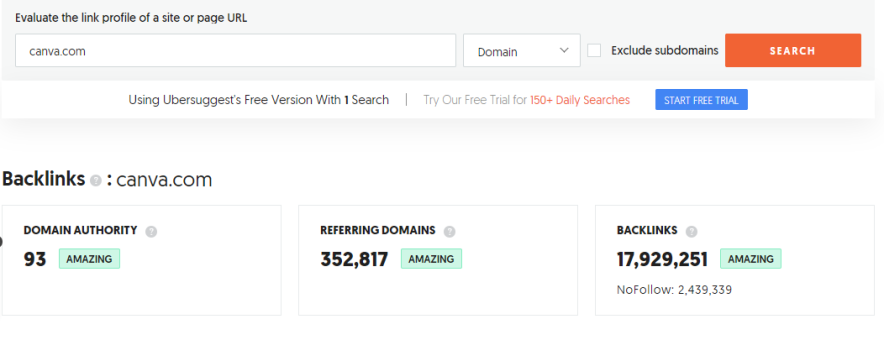
So, how did a SaaS company like Canva build such a HUGE backlink profile?
Here are a few ways you can replicate what Canva did to build backlinks to your SaaS website in 2024.
Creating informative content
Canva runs a blog where it regularly publishes high-quality content on various topics, including;
- Marketing
- Business
- Design
- Branding and more
Most of their blog posts are very comprehensive and informative, and they’re shared thousands of times on social media. Some of its free guides on marketing and design also attract hundreds (if not thousands) of backlinks organically.
So, if you’re running a SaaS website, take inspiration from Canva’s content to learn how you too can create amazing content to earn backlinks naturally.
Here are some effective tips for you to create content that attracts links;
- Identify topics that have the potential to do well in Google. Pick evergreen topics so you can create long-form content or free guides. If you pick epic topics, you can keep updating them regularly even after a year or two.
- Find your competitors’ top posts. Use Semrush to find ALL the top pages of your competitors that have the most number of backlinks. You can create 10x better content.
- Create infographics and appealing images to include within your blog posts. We’ve organically built many backlinks to our site by creating engaging images around popular topics. You too, can do the same, as images are the best way to attract links.
- Create unique and original content. Gone are the days when people used to link to average content. People are more likely to link to content that is new and different. Try to come up with fresh content ideas and find a unique perspective on your topics.
Email outreach
Canva is extremely good at running email outreach campaigns. It often runs a blogger outreach program to acquire backlinks from high-quality websites.
For example, they might contact a blog owner who wrote a post about the best design tools for small businesses and ask if they would like to add a link to Canva.
Here’s an example of an email pitch sent by Canva;
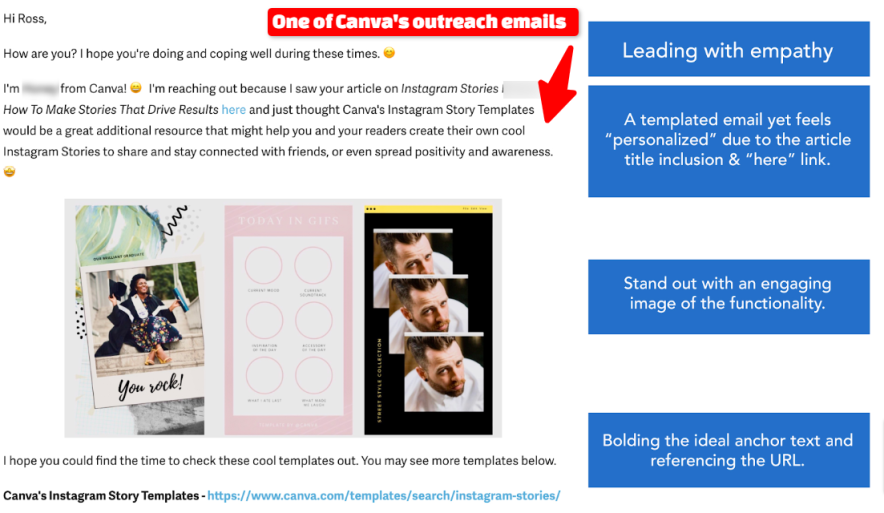
As you can see above, they carefully craft their emails. They’re really short and compelling.
Here are some quick tips for using email outreach to acquire links;
- Create a list of bloggers and website owners who are already linking to your competitors’ sites. You can use tools like Semrush to find the backlink sources of ANY website or domain easily. If someone’s already linking to your competitors, you too, can do the same with better content.
- Personalize your emails. Use their names while sending out an email. Don’t send bulk emails.
- Keep your emails short and sweet. Use strong calls to action at the end of your email.
- Follow up. In email outreach, following up is important. If you don’t get a response within a week, send out another short email.
5. Don’t ignore technical SEO
When it comes to search engine optimization, most people prioritize on-page and off-page optimization and often forget technical SEO.
You can’t ignore technical SEO, especially when you’re running a SaaS website.
Technical SEO involves improving the technical aspects of your website, such as;
- Crawling
- Indexing
- Rendering
- Website architecture
- Sitemaps and more
Here are a few important things you can do immediately to improve the overall technical SEO of your SaaS websites.
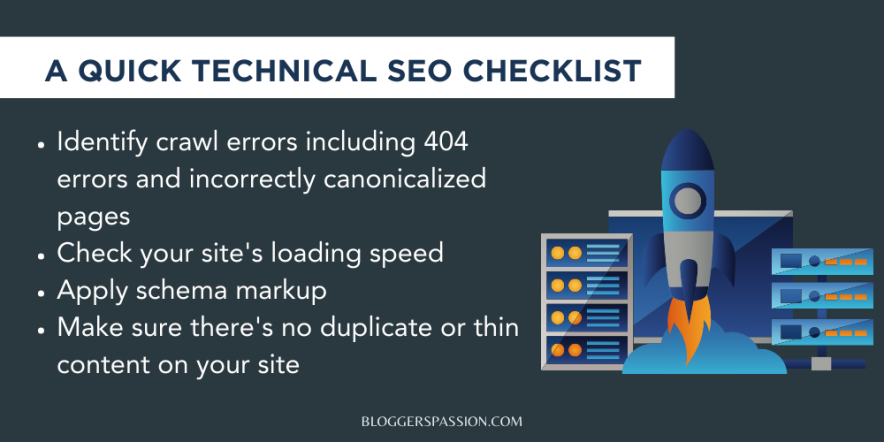
- Reclaim lost links. Sometimes, you might change your URLs. In that case, you’ll lose all the incoming backlinks that are pointing to them. You can fix this problem and reclaim all these lost links by adding 301 redirects from your old URLs to the new ones.
- Fix your broken links, as Google hates to show 404 error pages. You can use tools like Xenu’s Link Sleuth or Screaming Frog to find broken links on your site.
- Always link to other relevant pages on your website, as interlinking improves the overall crawling rate of your site. Also, it passes link juice to other important pages on your site, which helps with better rankings.
FAQs | SEO for SaaS Startups
Here are some FAQs on SaaS search engine optimization.
SaaS SEO refers to ALL the best SEO practices to improve the online visibility of websites that offer software-as-a-service (SaaS), such as HubSpot, Semrush, Ahrefs, etc.
Some of the best ways to do SEO for Saas websites include;
– Build a relevant keyword list
– Identify and analyze competitors top-performing pages
– Create content based on the user intent
– Build topic clusters for topical authority
To rank a SaaS website, you need two things: high-quality content and lots of backlinks.
Saas SEO requires a more specific approach to target a highly relevant audience and customers, whereas, in traditional SEO, you can target a broad set of audiences.
Some of the useful SaaS SEO tools are;
– Semrush
– Ahrefs
– Google Search Console and Google Analytics
– Screaming Frog
Related Posts:
- Enterprise SEO Strategy: How to Optimize an Enterprise Website
- ChatGPT for SEO: How to Use It to Improve Your Website’s SEO
- SEO vs OSO (Comparison & How to Prepare for Organic Search Optimization)
- Organic SEO 2024: 6 Best Strategies to Improve Organic Search Rankings
- Homepage SEO 2024: A Complete Guide for Beginners
Final thoughts on the SaaS SEO guide
Remember one thing: SaaS customers are ALWAYS looking for long-term relationships with a SaaS company. For example, we’ve been using the SEO software Semrush since 2016. We can’t move to another tool so easily, as we became loyal as the company grew.
The same applies to most SaaS startups: keep providing HUGE value, and you’ll keep your customers for life. And the best way to attract loyal customers is to optimize your website for search engines.
What are your thoughts on SEO for SaaS websites? Have any questions? Let us know in the comments.
![11 Best Digital Products that You Can Sell Today [2023 List]](webp/best-digital-products.webp)
